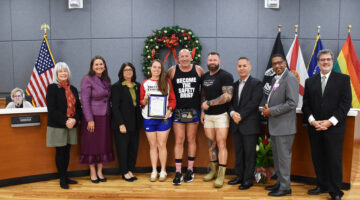Key West good Samaritan asks help relocating Osprey nests
BY PRU SOWERS
KONK LIFE STAFF WRITER
Joe Hall wouldn’t exactly call himself a bird lover or a “tree hugger,” as he says, but something about Ospreys touched his heart.
The long-time Key West resident was moved recently when he heard about an Osprey nest being taken down from a mobile cell tower unit in Key West. Two Ospreys had made a bad decision on where to build their new nest, since the mobile unit installed after Hurricane Irma isn’t going to stay in place forever. Because no eggs had been laid yet, Hall said, the company received permission to remove the nest.
But that got him thinking about the birds, which mate for life and return each year to the same nest to raise their chicks. Osprey are actually a species of hawk and are known for building their nests on tall structures, including telephone poles, channel markers and nest platforms designed especially for the birds. These three-by-three-foot wooden platforms have become an important tool in reestablishing Ospreys in areas where they had disappeared due to pesticide use.
No one knows exactly how many Ospreys live in the Florida Keys. Mark Hadden from the Key West Audubon Society did an informal survey after Hurricane Irma and estimated there were about 20 Osprey platforms in the Keys, about 10 of those in the middle and Lower Keys.
“About half of them were damaged or completely knocked down by Irma. We’re working towards putting some of them back up, but it’s difficult trying to find out exactly who owns which pieces of land and what kinds of permissions you need to rebuilt them,” Hadden said. “But we are working towards getting as many of them as we can restored.”
Enter Joe Hall, who has been talking to anyone he thinks might be willing to help put up a nest platform, either by putting it on their property or helping with the installation. He contacted the Key West City Public Works Department and Keys Energy Services about using their bucket trucks to lift the heavy platforms and install it on a pole. He also talked to the Key West Wildlife Center, which has five nest platforms ready to go for free to a new home.
“We just have to find the people,” said Peggy Coontz, animal care director at the center. “Anyone can put up a pole and an Osprey platform as long as it’s not blocking any electrical lines.”
“You have to agree to leave the pole there a couple of years because they do come back to their nest,” Hall said.
Osprey have a wingspan up to six feet and, in addition to their unusual nesting habits, are unique birds of prey because they are the only raptor to exclusively eat fish. They can swoop into the water from high above, diving up to three feet below the surface to grab a fish. After their chicks are strong enough to live on their own, Osprey mates migrate individually as far south as South America. Mates won’t see each other until they return to their original nest to hatch a new brood.
Ospreys are particular when it comes to nest location. Ideally, the pole should be between 20 and 100-feet high and within one mile of open water. The nest pole should be in an open area with no overhead canopy or interfering vegetation. If there are electrical lines in the space, simply build the pole higher than the power lines.
[livemarket market_name="KONK Life LiveMarket" limit=3 category=“” show_signup=0 show_more=0]


No Comment